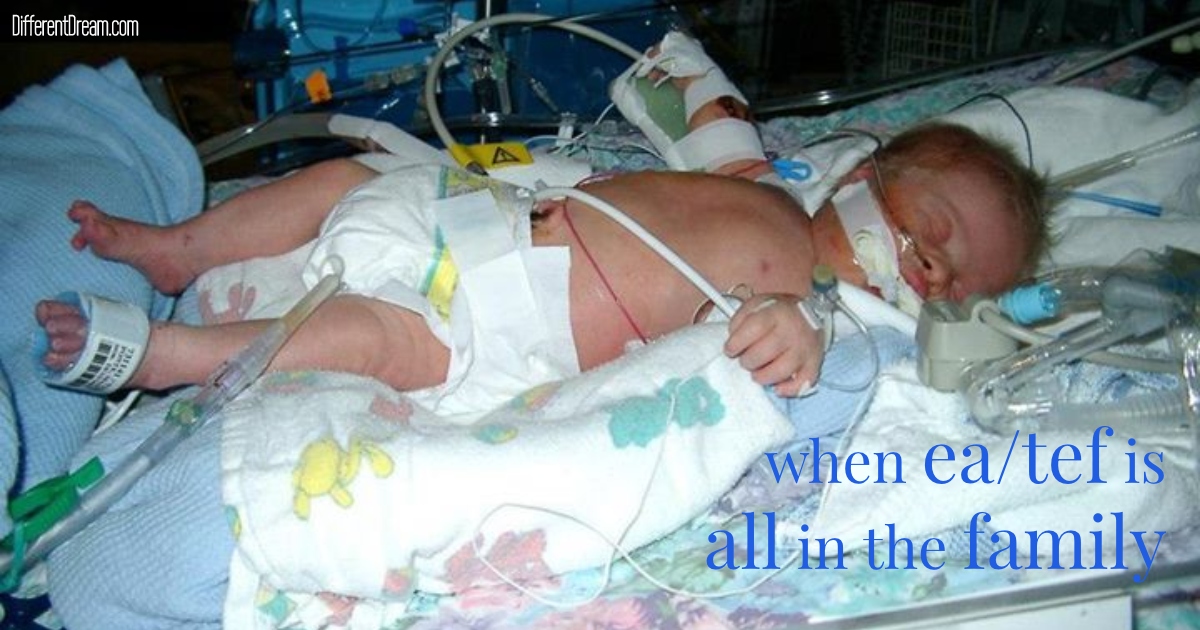EA/TEF Is All in the Family for this Mother and Son

EA/TEF is all in the family for this mother and son. Mom Corrin Ponte, who was born with this rare condition and whose son has it too, recounts both stories. From her unique vantage point, she also shares her best tips for parents raising their own EA/TEF babies.
I was transferred to Stanford NICU at 2 days old where scans showed a connection between the trachea and the distal esophagus and proximal esophagus ending in a blind pouch–EA/TEF. I had surgery to repair the defect and was discharged home at 3 weeks of age.
After a few weeks at home, I stopped breathing and turned blue. My mom pounded on the neighbor’s door. No answer. A teenager parked nearby noticed and performed CPR, resuscitating me.
Back at Stanford they found the repaired site had narrowed to the size of a pinhole. I spent the next 2 months in the hospital with life-threatening episodes. Eventually, they inserted a g-tube (feeding tube) so I could go home.
Fast forward to adulthood and my first pregnancy.
Between weeks 18-20 I had a routine ultrasound. The technician saw a tiny “stomach bubble” and had the radiologist take a look. I was referred to a perinatologist who said, “it’s probably fine; come back in 8 weeks.”
Knowing my own history, I wasn’t comfortable with the wait and self-refer to University of Washington perinatology. They saw a tiny stomach bubble and increased amniotic fluid and said there was a 90% + chance that my baby had EA/TEF. I left the appointment feeling confident that my child would be born with the same defect and that he would come home after a successful surgical repair or with a feeding tube. After all, EA/TEF is all in the family for me.
As I was a nurse, I requested my medical records from birth. Soon a 4-inch stack of records arrived! I poured through them. They gave me a glimmer of what my non-medical parents dealt with and gave me the reassurance that I needed to prepare for my son.
Mason was delivered via c-section at 35 weeks. He was evaluated and confirmed to have EA/TEF and Down syndrome. That was a complete surprise! He was transferred to Seattle Children’s Hospital within 4 hours. His surgery was the next day and was successful! He spent 2 weeks in the NICU and was discharged after 3 weeks – including modified feedings and a wedge to sleep on.
The first 12 years of his life were filled with appointments, therapy, hospitalizations, illnesses, and surgeries. He is now 18 and doing much better. Because EA/TEF is all in the family for us, I created these tips to help other parents.
- Take a breath! You can do it!
- Make a binder to organize notes about medication, treatments, and doctors.
- Create an “About Me” handout for school personnel.
- Create a “babysitting guide” with important health information for emergency medical situations and tips for dealing with stuck food.
- Encourage caregivers and family to learn CPR and Heimlich.
- Have a list of banned foods that are choking hazards for your child.
- Work with your child to learn his or her choking hazards.
- Send only safe foods to school.
- Work with your child’s school nurse to create a 504, Individual Health Plan, or Emergency Care Plan. If your child needs adult support during school, make sure it’s written and make sure back-up staff are trained. Remember parties/field trips/special events.
- Provide information from TOFS and EATEF: ‘Tracheomalacia and the TOF cough’, ‘Chest infections and wheeze’, and ‘A Guide for Teachers and Caregivers’ for school nurses and educators.
- Create an “About Me” presentation for your child’s class. Explain why your child has eating restrictions, what those restrictions are, and go over typical EA/TEF sounds like noisy breathing and a barky laugh.
Do you like what you see at DifferentDream.com? You can receive more great content by subscribing to the monthly Different Dream newsletter and signing up for the daily RSS feed delivered to your email inbox. You can sign up for the first in the pop up box and the second at the bottom of this page.

By Corrin Ponte
Corrin Ponte lives in Washington state with her two children: Lauren and Mason and their pets. Aside from TEF/EA, Mason also has Down syndrome, dysphagia, tracheomalacia, asthma, hypothyroidism, and obstructive sleep apnea. Corrin has been a nurse 24 years and received her Master of Science in Nursing Education in 2019. She has been published in ‘Individualized Healthcare Plans for the School Nurse’ (2017) and in ‘Immunology and Allergy Clinics of North America: Comprehensive Care in the Allergy/Asthma office’ (1999). She also served as a board member for the IDEA project which provides interactive disability education awareness at schools. Corrin works as a school nurse and helps integrates students with complex medical issues and students with disabilities.
Related Posts
How Do I Let Go of My Adult EA/TEF Child?
Valeria Conshafter explores the question “How do I let go of my adult EA/TEF child?” for EA/TEF Awareness Month.
How Can an EA/TEF Parent’s Anxiety Be Held in Check Before their Child Starts School?
Karena Skibinski shares her answers to the question: How can an EA/TEF parent’s anxiety be held in check before their child starts school?
What’s Working on Your ADHD Journey?
Guest blogger Lisa Pelissier provides ADHD management tips from her own journey and asks, “What’s working on your ADHD journey?”






0 Comments